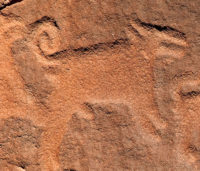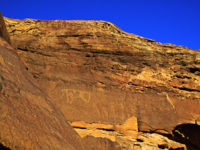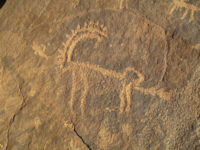This section provides the visitor with the content and background for the subjects in the petroglyphs, such as humans, animals, and plants. It also provides interpretations of complex scenes that incorporate many figures that together convey an event. The scenes mostly depict activities relating to hunting and warfare. In this section, the visitor will learn about the people who created the rock art of Saudi Arabia and their environment.
Subjects & Scenes
Examples:
-
Canaan Dog
The dogs illustrated in the Neolithic hunting scenes at Jubbah and Shuwaymis appear to be medium-sized, with erect ears and a curly tail. They do not have a slender build or long legs like a saluki or other sighthounds, but rather have average length legs and a strong, but not massive body.
-
Arabian Leopard
Leopards are large and powerful cats, although they are still the smallest of the four cats in this genus. The Arabian leopard is smaller than other subspecies. Their coat varies from pale yellow to tawny, with small spots that are densely packed hollow rosettes. The leopard’s flat cranial profile and tendency to hold its mouth open. The skull profile is distinctively flat, not [...]
-
Hunting
During the Neolithic, hunting scenes were prevalent. They were fairly stereotypic, with one or more of a particular prey species in the center of the scene and a hunter standing behind, poised to fire his weapon.
-
Ibex
The ibex is similar to the wild goat in terms of the shape of its head, body, and tail. Like the goat, it has scimitar horns that curve backward in a large semi-circle, but with the addition of a series of regularly spaced transverse ridges along the outer edge of the curve. Ancient artists depicted these ridges distinctly on the more realistic panels, however, where a caprine [...]



